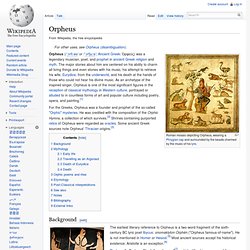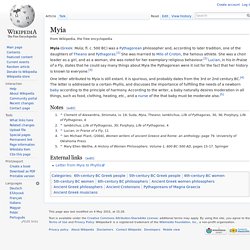

Orphism (religion) Orphic mosaics were found in many late-Roman villas Orphism (more rarely Orphicism) (Ancient Greek: Ὀρφικά) is the name given to a set of religious beliefs and practices[1] originating in the ancient Greek and the Hellenistic world,[2] as well as by the Thracians,[3] associated with literature ascribed to the mythical poet Orpheus, who descended into Hades and returned.

Orphics also revered Persephone (who annually descended into Hades for a season and then returned) and Dionysus or Bacchus (who also descended into Hades and returned). Orpheus was said to have invented the Mysteries of Dionysus.[4] Poetry containing distinctly Orphic beliefs has been traced back to the 6th century BC[5] or at least 5th century BC, and graffiti of the 5th century BC apparently refers to "Orphics".[6] The main elements of Orphism differed from popular ancient Greek religion in the following ways: Compare with Christianity, Hinduism, Buddhism and Gnosticism. I am a son of Earth and starry sky. Orpheus. Roman mosaic depicting Orpheus, wearing a Phrygian cap and surrounded by the beasts charmed by the music of his lyre.

Orpheus (/ˈɔrfiːəs/ or /ˈɔrfjuːs/; Ancient Greek: Ὀρφεύς) was a legendary musician, poet, and prophet in ancient Greek religion and myth. The major stories about him are centered on his ability to charm all living things and even stones with his music, his attempt to retrieve his wife, Eurydice, from the underworld, and his death at the hands of those who could not hear his divine music. As an archetype of the inspired singer, Orpheus is one of the most significant figures in the reception of classical mythology in Western culture, portrayed or alluded to in countless forms of art and popular culture including poetry, opera, and painting.[1] Background[edit] The earliest literary reference to Orpheus is a two-word fragment of the sixth-century BC lyric poet Ibycus: onomaklyton Orphēn ("Orpheus famous-of-name"). Mythology[edit] Early life[edit] Travelling as an Argonaut[edit] Orphism (religion) Persephone. Persephone as a vegetation goddess and her mother Demeter were the central figures of the Eleusinian mysteries that predated the Olympian pantheon and promised the initiated a more enjoyable prospect after death.

Persephone is further said to have become by Zeus the mother of Dionysus, Iacchus, or Zagreus, usually in orphic tradition. The origins of her cult are uncertain, but it was based on very old agrarian cults of agricultural communities. Name[edit] Etymology[edit] Persephone or "the deceased woman" holding a pomegranate. Persephatta (Περσεφάττα) is considered to mean "female thresher of corn," going by "perso-" relating to Sanskrit "parsa", "sheaf of corn" and the second constituent of the name originating in Proto-Indo European *-gʷʰn-t-ih, from the root *gʷʰen "to strike".[8] An alternative etymology is from φέρειν φόνον, pherein phonon, "to bring (or cause) death".[9] Myia philosopher Daughter of Theano and Pythagoras.
Myia c. 525 BCE Myia ( or Myria) is a daughter of Theano and Pythagoras.

She had an elder sister, Damo and a brother, Telauges. It appears that she, like the other children, studied at the school in Crotona. We know that she married Milo, an Olympic athlete, who competed in wrestling. Milo won accolades from the Panhellenic or "All-Greek" athletic circuit, comprising the regular festivals at Olympia, Delphi, Nemea and Isthmia. Milo was legendary both for his athletic prowess and his appetite and is mentioned by Socrates in one of the Dialogues of Plato. Theano of Crotona, philosopher, mathematician. Theano of Crotona (Italy) c. 546 BCE Theano was the daughter of Brontinus, a physician and an Orphic disciple She was born in Crotona c. 546 BCE.

She was educated. She was a fine mathematician who later in life wrote a treatise describing the 'Golden Mean". She was very interested in ideas and when Pythagoras came to Samos, she went to hear him. She and Pythagoras married although she was 36 years his junior. She taught mathematics in Samos and Croton and is said to be the author of the treatise on the Golden Mean, an important concept in mathematics. the 'Golden Mean' is found in nature and used in both art and architecture. Myia. One letter attributed to Myia is still extant.

It is spurious, and probably dates from the 3rd or 2nd century BC.[4] The letter is addressed to a certain Phyllis, and discusses the importance of fulfilling the needs of a newborn baby according to the principle of harmony. According to the writer, a baby naturally desires moderation in all things, such as food, clothing, heating, etc., and a nurse of the that baby must be moderate also.[5] Notes[edit] Pythagoras Biography - Profile, Childhood, Life And Timeline.